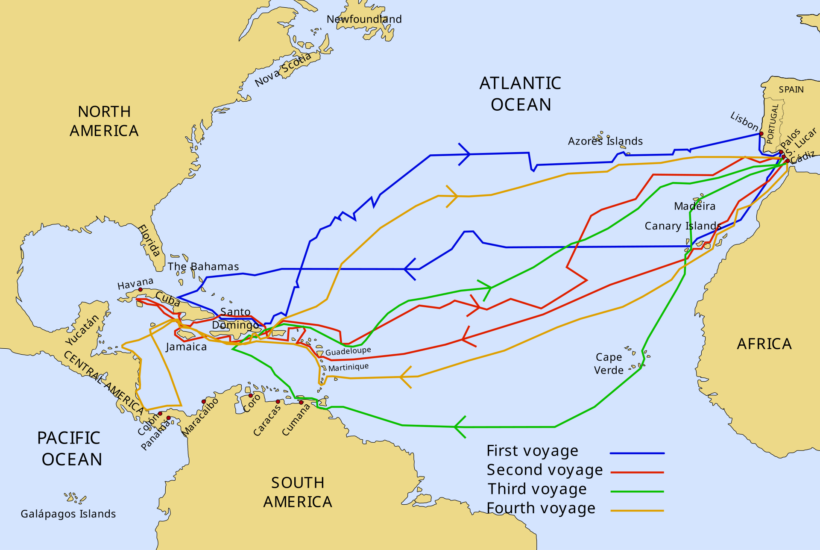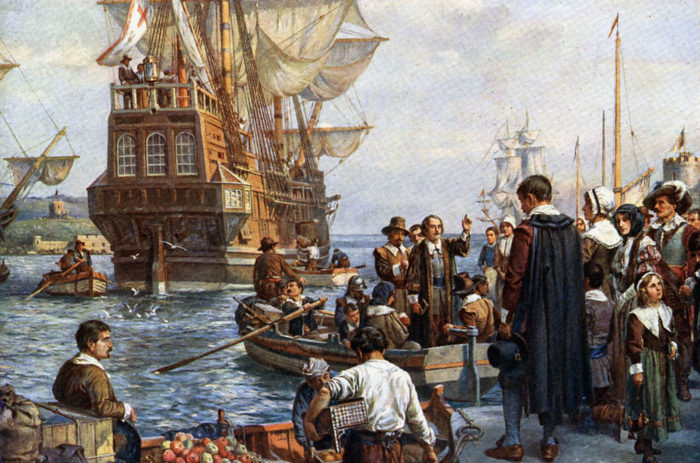
(by Arnold K. Garr, BYU) – Historians have written about Columbus’ first voyage to America from many points of view. Most secular historians, however, have placed little emphasis on the most important theme of all—the fact that Columbus was guided by [God]. Beginning with the decision he made concerning his point of departure, and continuing all the way through to his return voyage to Spain, we can find numerous junctures at which the Lord manifested His hand in Columbus’ key decisions.
Before 1492, other navigators had tried unsuccessfully to explore westward from the Azores Islands (800 miles west of the coast of Portugal), assuming that this was the best place from which to set sail (Morison 1:97–98). Although the Azores were the western-most islands known in the Atlantic, Columbus chose to sail from Palos, Spain, to the Canary Islands (off the west coast of Africa) and from there, to launch his voyage into the vast unknown. By doing so, he caught the tradewinds blowing from the northeast to the southwest and avoided the headwinds which blow from the west to the east in the vicinity of the Azores (Nunn 37–38,42).
The route Columbus chose has stood the test of time: five hundred years of sailing have proven it the best possible course for sailing west from southern Europe to North America. Geographer George E. Nunn suggested that Columbus’ successful navigation was the result of “an application of reason to . . . knowledge” (Nunn 50). Columbus, however, gave credit to the Lord. Even though he was a successful seaman and an accomplished navigator, he said, “With a hand that could be felt, the Lord opened my mind, to the fact that it would be possible to sail from here to the Indies.” (West and Kling 105).
Columbus experienced relatively easy sailing during the entire outward voyage; had he not done so, he likely would not have reached America before his crew mutinied. There was one occasion, however, on 23 September, when the sea became calm, and the ships were stalled for part of the day. Columbus noted in his journal that the crew, which had not seen land for some days, began to complain that since there were no heavy seas in the region, the wind would never blow hard enough to return to Spain. Soon thereafter, the sea mysteriously rose without wind, astonishing the crew (Dunn and Kelly 41). The Admiral considered this a divine miracle. He said, “the high sea was very necessary to me, [a sign] which had not appeared except in the time of the Jews when they left Egypt [and complained] against Moses, who took them out of captivity” (Ibid).
On the way to America, Columbus changed course only twice during the entire 33 days at sea. The first alteration was on 7 October. Until that time, Columbus had sailed due west for 28 days. Then he noted in his journal that a great multitude of birds passed over, going from north to southwest. Bartolome de Las Casas, the man who transcribed Columbus’ journal, wrote that from this observation, the Admiral “decided to alter course and turn the prow to the WSW [west southwest]” (Fuson 71). Samuel Morison [said] that if Columbus had not changed course, “the voyage would have taken a day longer” (Morison 1:283). That extra day would have been critical, since two days before the eventual sighting of land, the crew threatened mutiny. Every extra day at sea heightened their anxiety; the Admiral’s time-saving change of course on 7 October, therefore, just may have saved the expedition.
The story of the threatened mutiny is one of the most dramatic episodes of the first voyage. The incident took place on Wednesday, 10 October 1492, after they had been at sea for over 31 days without seeing land. The sailors, who had been concealing their discontent, now openly threatened insurrection. They had come to believe that Columbus, the foreigner from Genoa, had deceived them; they supposed he was leading them on a journey from which they would never return. According to one account, the sailors even conspired to do away with their leader, whom they “planned to throw into the sea” (d’-Anghera 1:59–60). Yet, “Columbus, by using gentle words, holding out promises and flattering their hopes, sought to gain time, and he succeeded in calming their fears” (Ibid).
Others have stated, after the fact, that at this juncture, Columbus promised the men that they would return if they did not sight land within two or three days (Morison 1:286,290–91,292n6). Although Columbus did not record this oft-repeated assertion in his journal, he did report that “I also told the men that it was useless to complain, for I had started out to find the Indies and would continue until I had accomplished that mission, with the help of Our Lord” (Fuson 72; emphasis added). This incident serves as an excellent example of Columbus’ determination and faith in God.
The second instance in which the Admiral altered his route was after sunset on 11 October, just a few hours before land was sighted. For no apparent reason, he gave orders to change direction from west southwest back to the original course of due west (Dunn and Kelly 59). He gave no explanation for the change, but it was, nevertheless, an excellent choice. Had he continued on the west southwest course instead of steering due west, he would have missed the island of San Salvador, and would likely have ended up on the deadly reefs along the coast of Long Island (in the Caribbean), perhaps never returning to Spain (Morison 1:295). Many historians have attributed these changes in course to luck or chance, but Las Casas said, “God gave this man the keys to the awesome seas, he and no other unlocked the darkness” (Las Casas 35), and I agree.
Having made this second course correction, Columbus was then right on target, and just in time to meet with his destiny—to discover the New Land. That evening as the crew gathered for prayer, the Admiral, “spoke to the men of the favor that [the] Lord had shown them by conducting them so safely and prosperously with fair winds and a clear course, and by comforting them with signs that daily grew more abundant” (Ferdinand 58). His policy since reaching a point 700 leagues beyond the Canaries had been not to sail at night, but the crew’s desire to see land was so great that Columbus decided to sail through the darkness (Morison 1:294). He commanded the night watch to keep an especially sharp lookout because he was confident that land was nearby. In addition to an annuity of 10,000 maravedis guaranteed by the Sovereigns, the Admiral also promised to give a silk jacket to the first sailor who sighted land (Dunn and Kelly 63).
About 10 o’clock that night, Columbus saw a light in the distant dark, but it was so faint that he did not publicly announce it. He did, however, bring it to the attention of Pedro Gutierrez, who also acknowledged seeing the flickering light. Rodrigo Sanchez was also called on to observe the light, but he claimed he could see nothing from where he was (Phillips and Phillips 153). Notwithstanding Columbus’ glimpse of the light, it was some four hours later, at about two in the morning on 12 October, that the fleet sighted land for certain. Rodrigo de Triana, a sailor on the Pinta, shouted, “Tierra! tierra!” while the fleet was still two leagues off shore (Morison 1:298). Martin Pinzon, the captain of the Pinta, quickly verified Triana’s claim and then fired a cannon shot, which was the prearranged signal for sighting land.
One can only imagine the gratitude and relief they all must have felt, after more than a month of anxious days at sea, when their eyes first saw this obscure little island in the middle of the tropical Caribbean Sea. It goes without saying that the crews were ecstatic and their respect and admiration for the Admiral soared, literally, overnight.
For Columbus, this historic sighting was a rendezvous with destiny. He had proven, in spite of mounting opposition and a lack of faith on the part of his crew, that it was possible to sail westward across the great Atlantic. According to his agreement with the monarchs, Columbus officially became Admiral of the Ocean Sea, simultaneously gaining the titles of Viceroy and Governor of this island at the moment he discovered it. Professor Hugh Nibley aptly put this celebrated moment into proper perspective when he said: “Everything else in Columbus’ life is subservient to the carrying out of that one mission. The aim and purpose of all his work and suffering was what happened at 2 a.m. on the morning of October 12, 1492” (Nibley 320).
Impatient and anxious to explore their new discovery, the crew waited through the night, and sailed excitedly to shore at daybreak. Upon reaching dry ground, the landing party knelt, kissed the sand with tears of joy, and offered prayers of thanks to God. Rising from his knees, the Admiral named the island San Salvador (Holy Savior), thus beginning a personal tradition of giving names of religious significance to many newly discovered lands (Ferdinand 59). In deference to the crown, Columbus dedicated San Salvador, which lay off the northern coast of Cuba, to the Spanish monarchs.
Excerpted from Chapter 5: First Voyage to the Americas of Arnold K. Garr’s book Christopher Columbus published 1992 at Brigham Young University rsc.byu .edu). Reprinted here for educational purposes only. May not be reproduced on other websites without permission from Brigham Young and Arnold Garr.
Bibliography:
- Dunn, Oliver and James E. Kelley, Jr. The Diario of Christopher Columbus’ First Voyage to America, 1492-1493. Norman, OK: University of Oklahoma Press, 1989.
- Morison, Samuel Eliot. Admiral of the Ocean Sea. 2 vols. Boston: Little, Brown and Co., 1942.
- Nibley, Hugh. “Columbus and Revelation.” The Instructor (Oct 1953) 88:319–20.
- Nunn, George E. The geographical Conceptions of Columbus. New York: American Geographical Society, 1924.
- Phillips, William D., Jr., and Carla Rahn Phillips. The Worlds of Christopher Columbus. Cambridge: Cambridge University Press, 1992.
- West, Delno C. “Writings: Marginalia.” The Christopher Columbus Encyclopedia. 2 Vols. Ed. Silvio A. Bedini. New York: Simon & Schuster, 1992. 2:746–48. ————. and August Kling. The Libro de las profecías of Christopher Columbus. Gainesville: University of Florida Press, 1991.


